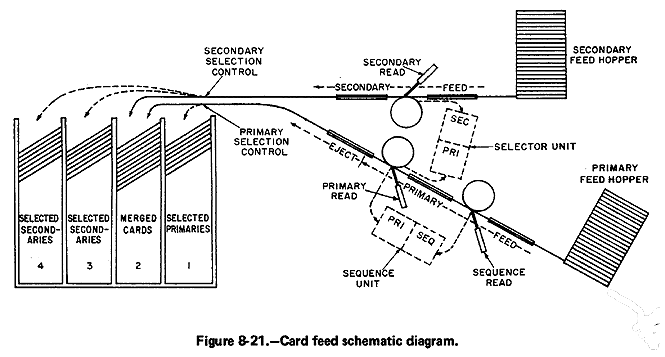Since then I have added material occasionally.
Items are certainly not complete, and may be inaccurate.
Your information, comments, corrections, etc. are eagerly requested.
Send e-mail to Ed Thelen. Please include the URL under discussion. Thank you ***
| Manufacturer | IBM |
| Identification,ID | Type 077 Collator |
| Date of first manufacture | 1937 |
| Number produced | - |
| Estimated price or cost | $80/month (1955) |
| location in museum | - |
| donor | - |
Contents of this page:
- Photo
- Placard
- Architecture
- Special Features
- Historical Notes
- This Specimen
- Interesting Web Sites
- Other information
| IBM Type 077 Collator, |
| - |
|
from the U.S. Navy training manual "Digital Computer Basics" dated 1978, pages 185 - 187
Collators The collator ... is a card device which will merge two sets of cards without disturbing their original sequence, and, in addi- tion, will select cards to be kept out of the merged sequence. Two hoppers and feed units (fig. 8-21), along with four or five pockets for stacking cards are provided. The two feed units in the collator are called the PRIMARY FEED and the SECONDARY FEED. Cards placed in the primary feed hopper are referred to as primary cards, and those placed in the secondary feed hopper are called secondary cards. Cards are placed in the hoppers face down, with the 9 edge toward the throat. Most collating operations require that two numbers be compared. For example, when checking sequence, the number coded on one card must be compared with the number on the preceding card to see if the cards are in the proper order. Also, when merging, the number coded on a card in one feed unit must be compared with the number on a card in the other feed unit to see which cards is to be fed first.
When one card is compared with another, one of three possible conditions may exist with regard to the number coded on the card; it may be lower than, equal to, or higher than the number on the other card. Card feeding and selection can be controlled by control panel wiring (not shown) when either of these conditions occurs. Note from the illustration (fig. 8-21) that the primary cards pass two sets of brushes, while the secondary cards pass only one set. The readings from the two sets of brushes in the primary feed unit can be compared with each other, or with the readings from the secondary brushes. Since the secondary feed unit contains only one set of brushes, readings from the secondary brushes can normally be used only for comparing with readings from the primary brushes. |
from
Orange Coast College
The Type 77 Electric Punched Card Collator performs many card filing and pulling operations. As a filing machine, the Collator feeds and compares simultaneously two groups of punched cards: records already in file, and records to be filed. These two groups are merged in correct numerical or alphabetical sequence. If desired, the machine will at the same time remove from either group, those cards which are matched by cards in the other group, or all but those cards which are matched, or other selected cards. |
Historical Notes
from Orange Coast College
|
This Specimen
| - |
| - |
If you have comments or suggestions, Send e-mail to Ed Thelen
